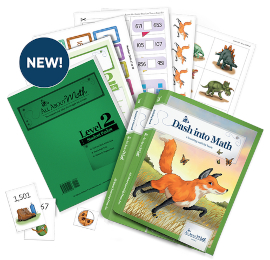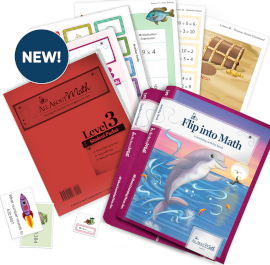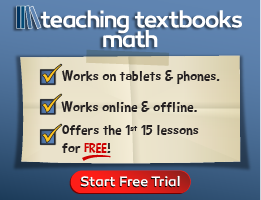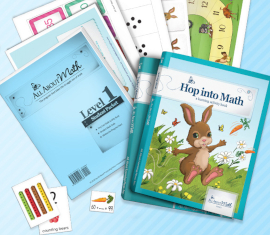All About Math will eventually be a five-level program for kindergarten through about fifth grade. Levels 1 through 3 are the first to be published, and all levels should be available by the end of 2026. The first two courses overlap traditional grade levels, with Level 1 covering content for kindergarten and part of first grade. Level 2 completes first grade and covers all content for second grade. The last three levels correspond more closely to grade levels.
Each level has a teacher’s manual and a student packet. The student packet includes a student activity book, a set of cardstock math tools (e.g., numeral cards and an addition and subtraction mat for Level 1), and stickers. A one-time purchase of a set of math manipulatives is required along with a whiteboard and dry-erase markers.
The same set of manipulatives is used for all five levels. The manipulatives kit, packaged in a plastic storage bin, contains counting bears, connecting cubes, two-color counters, Base Ten Blocks, fraction tiles, a ruler, a protractor, and a dry-erase pocket. Some of the cardstock math tools, like the addition and subtraction mat, are placed in the dry-erase pocket so students can write with markers and reuse the tools.
Teacher's Manuals
This is a multisensory math program, requiring frequent interaction and discussion between teacher and student. Lessons are taught from the teacher’s manual, with the activity book pages and manipulatives used as supportive tools. The teacher’s manuals (some more than 500 pages long) explain how the courses work and provide thoroughly scripted lessons. Explanations of how the courses work are also available via free videos.
The teacher’s manuals provide preparatory instructions for each lesson in a "Before You Begin" section that lets you know the objectives and required manipulatives and math tools. The manuals also explain new concepts, such as subitizing—“the ability to quickly and accurately recognize the number of items in a small group without needing to count them individually” (Level 1 Teacher’s Manual, p. 35)—and summarize what will happen in the lesson and why. These explanations help parents understand the program at a deeper level, even if they have a poor math background themselves.
To teach a lesson, parents read the lesson directly from the teacher's manual, direct activities, and ask questions following the step-by-step lesson plans. Parents are encouraged to spend about 20 minutes daily on lessons and move at their student's pace, so it's appropriate for lessons to take more than one day. Among the lessons are five titled “Show What You Know,” which are used rather than tests to assess student knowledge through an interactive session.
Students learn new concepts through concrete learning experiences, then transfer learning to pictorial and then abstract ways of working with the concepts. Children are gradually introduced to standard formats for problem-solving. Practice and review to ensure mastery are often accomplished with manipulatives and games, and optional activities are available at the end of each lesson for students who need more practice.
The multi-page lessons often take more than one session to complete for various reasons. Some lessons simply require more time to cover the material, or students might need more time to practice and master concepts. Students are to achieve mastery of each level before moving on. Lessons are completed at the student's pace, so some levels might take more than a year.
Every lesson includes a brief “Math Reflection” with scripted questions to prompt a dialogue with students. For example, parents might ask students to explain what strategy (or strategies) they could use to figure something out or what concept they want to practice more. These reflections help solidify learning and help parents spot gaps in their children's understanding.
Parents are provided with two resources for tracking student progress, both found in the activity book. The “Daily Review Tracker” is used to track the introduction and mastery of the skills taught in each course, and children affix a sticker to the “Progress Chart” as they master each lesson.
Appendices at the back of the teacher's manuals include a scope and sequence, a simple way to construct a game spinner, Guidelines for Using Manipulatives and Drawings, a glossary, and an index. Other resources in the appendices vary by grade level, such as the Number Reversal Solutions page for Level 1 and the Multiplication Table Answer Key in Level 3. The Guidelines for Using Manipulatives and Drawings reminds parents that children don’t need to complete every activity if they have already mastered a concept, especially those with hands-on resources. Even though lessons are scripted, parents are free to adapt to the needs of each child, sometimes skipping or adding multisensory elements.
Student Activity Books
The heavily illustrated student activity books (about 400 pages each) are printed in full color, and pages are perforated for easy removal. Some pages are used for games or are used with manipulatives, and some require written work. Pages 5, 7, and 8 have the progress-tracking resources used throughout each course, which parents can remove and keep handy.
See additional details for each level below my summary.
Summary
All About Math takes into account many common problems children encounter. For instance, both Level 1 and Level 2 use a mixture of styles for writing numerals to prevent children from confusing numbers like 6 and 9. (Six is written with a curved line coming down to the left and then forming a circle, while 9 is written in a ball-and-stick fashion.) This seems like an insignificant detail, but it can be important for children who have trouble differentiating the numbers.
In addition to paying attention to details, All About Math provides a thorough conceptual foundation for math by integrating manipulatives, games, and interaction. The scripted lessons make it easy for parents to teach without prior training. Suggestions and extra practice ideas are included to help parents be sensitive to the needs of each child and make adaptations as needed.
Level 1
Before starting Level 1, students need to be able to count to five and should be at least at the beginning stages of writing letters and numbers. Among other developmental prerequisites are the ability to follow multi-step directions, a 10-minute attention span, the ability to speak clearly and be understood, the ability to play games like Chutes and Ladders, and the ability to trace, copy, and draw simple shapes. You can use the free, online placement test to check if your child is ready for Level 1.
Topics covered in Level 1 include counting, one-to-one correspondence, identifying and writing numbers to 100, comparing amounts and numbers, addition (with sums up to 99), subtraction, place value, story problems, composing and decomposing numbers, counting by 10, and measurement with non-standard units.
The first half of Level 1 focuses on kindergarten concepts, while the second half focuses mainly on first-grade material. Lessons begin at a higher level than some kindergarten programs, so some kindergartners might need to move through lessons slowly at first. The first few lessons teach the skill of subitizing, which I described earlier. Children learn to do this for up to five items, using dot cards, counting bears, connecting blocks, “five frames,” activity pages, and games. Later, they will use “ten frames” and other resources for subitizing beyond five items.
The student activity book is titled Hop into Math, and Brinda the Bunny accompanies children through this course, appearing on pages in the teacher’s manual and on the cover of the activity book, Hop into Math. In addition, every lesson includes a “Brinda’s Math Fun” game-like activity. These generally use gameboards, cards, and other resources found in Hop into Math, and sometimes also use cubes, counting bears, or other manipulatives.
Level 2
 As mentioned above, this level completes first-grade concepts and covers all of second grade. Parents should use All About Math's free, online placement test before purchasing Level 2.
As mentioned above, this level completes first-grade concepts and covers all of second grade. Parents should use All About Math's free, online placement test before purchasing Level 2.
At this level, students learn place value up through 100,000, addition and subtraction up to 1,000, rounding numbers, the values of coins and dollar bills, time telling with analog clocks, how to solve story problems, multiples of 100, measuring in centimeters, and an introduction to fractions.
Flash the Fox accompanies students through Level 2, and the student activity book is titled Dash into Math.
Level 3
 Level 3 covers typical third-grade content, but parents should use the free placement test before purchasing.
Level 3 covers typical third-grade content, but parents should use the free placement test before purchasing.
Darby the Dolphin accompanies students through the course presentations in the teacher's manual and is on the front of the learning activity book for students, which is titled Flip into Math.
Plenty of review is built into this course, and it goes on to cover fractions (using models and diagrams), multiplication and division (within 100 with single-digit multipliers and divisors), reading and writing numbers up through 1,000,000, rounding, and two-step word problems.
Levels 4 and 5
Specific details for the other levels will be added as they become available.










